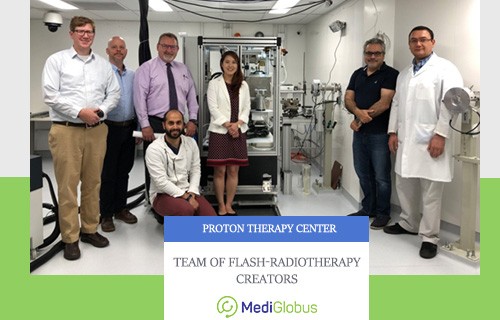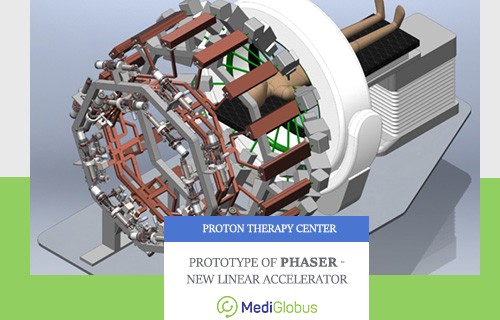The new 2020 year hasn’t even started yet, and the Roberts Proton Therapy Center has already discovered a new method of treating cancer. They call it FLASH radiotherapy. The Daily Mail has already called it the breakthrough of the year, and a revolution in oncology.MediGlobus answers readers’ most popular questions about this innovation.
WHAT IS FLASH RADIOTHERAPY?
FLASH-radiotherapy is a new method of irradiating tumor tissue. Instead of the usual x-rays, it uses protons – positively charged particles. This is the first case in medical history when the treatment of cancer does not use electrons to produce radiation. This is also where the name “proton therapy” comes from. And the best thing: flash radiotherapy is safer for the patient’s healthy tissue.

WHAT ARE THE RESULTS SO FAR?
Clinical trials on the efficacy and safety of FLASH radiotherapy were conducted on mice. Preliminary results show a 30% reduction in pulmonary fibrosis and an overall increase in survival.
Also, we can observe a decrease in spontaneous metastases of the exposed area.This gives hope that after proton radiotherapy, patients will enter a prolonged remission.
HOW IS FLASH RADIOTHERAPY DIFFERENT FROM REGULAR RADIOTHERAPY?
The duration of treatment is 100% shorter. Traditionally, a patient has to be exposed to a high dose of radiation 5 days per week for several months. Modern linear accelerators are very safe and quick. But even they can’t compete with the possibilities of FLASH therapy, which only requires one session.
One-second results. Usual treatments, on average, take 10-15 minutes. FLASH radiotherapy only needs one second. As a result, the healthy cells that would have been destroyed by the radiation during the remaining 1199 seconds, stay alive.
Protons are less toxic than x-rays. Long exposure to concentrated x-rays temporarily changes blood composition, and badly affects the stomach and liver functions. Proton radiation does not have these side effects.
FLASH radiotherapy does not depend on the tumor movement or breathing. Modern linear accelerators like RGRT Rapid Arc or TrueBeam have a breath control system. This reduces the chance of radiation damaging the healthy tissue. With FLASH therapy, the problem solves itself – irradiation is too quick to be affected by any movement.
WHAT TYPES OF CANCER WILL RADIOTHERAPY BE ABLE TO TREAT?
We expect to use FLASH therapy most effectively with stage 3 and 4 brain cancer. Thanks to its preciseness, other areas of the brain won’t be affected. Other than that, we could use it to treat tumors of stomach, prostate, breasts, lungs, skin cancer and lymphoma.
WILL THERE BE ANY SIDE EFFECTS?
Doctors have detected no life-threatening side effects of FLASH radiotherapy. Scientists at the Stanford University note that the group of mice that had received conventional radiotherapy developed stomach problems. In contrast, mice that treated with FLASH radiotherapy remained healthy. These results show that proton radiotherapy does not cause the side effects associated with traditional radiation exposure.
HAVE THERE BEEN HUMAN TRIALS? WHAT WERE THE RESULTS?
So far, there has been 1 case of doctors using FLASH radiotherapy on people. Using this method, they were able to cure a 75-year-old-man of cutaneous T-cell lymphoma. Before that, he had undergone 110 courses of radiation therapy. The trial used an experimental Oriatron eRT6 linear accelerator. The needed dose was delivered in 90 milliseconds. In 15 days, the patient’s tumor has reduced in size. 5 months after, it was gone. Doctors observed no toxic effects done to the skin.

Hopefully, this means that we are close to defeating cancer quickly and reliably. With these goals in mind, physicists and medical specialists are developing a PHASER linear accelerator. It will be able to deliver ultrahigh proton doses in a split second. This technology will be exclusive to medical facilities.
WHAT CLINICS WILL OFFER FLASH RADIOTHERAPY?
Foremost, it will become available in American hospitals. Yet, this country is the leader not only in medical innovations but also the expensiveness of healthcare. Israel will be able to purchase the same equipment. They are quick to equip new developments, and the cost is usually 40-60% lower than in the USA.
Patients should pay attention to the clinics that closely cooperate with the American infrastructure. They will be the first to implement the new technology and hire specialists with the required training. Among such hospitals are:
American Hospital in Istanbul (Turkey);
Sheba Medical Center (Israel);
Teknon Hospital (Spain);
KCM Clinic (Poland).
Follow our updates on the site and on social media. As soon as the method gets FDA approval, we will be the first to notify you!





